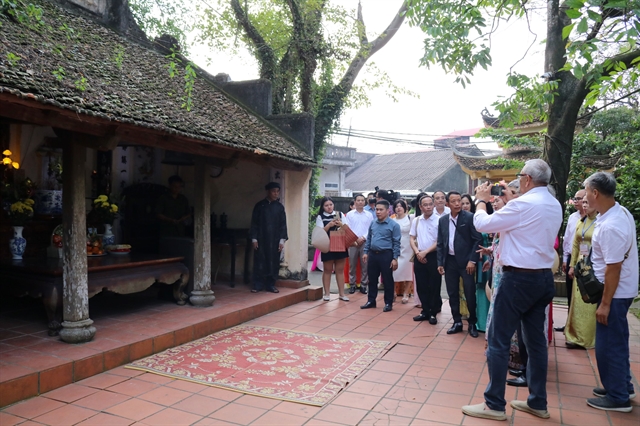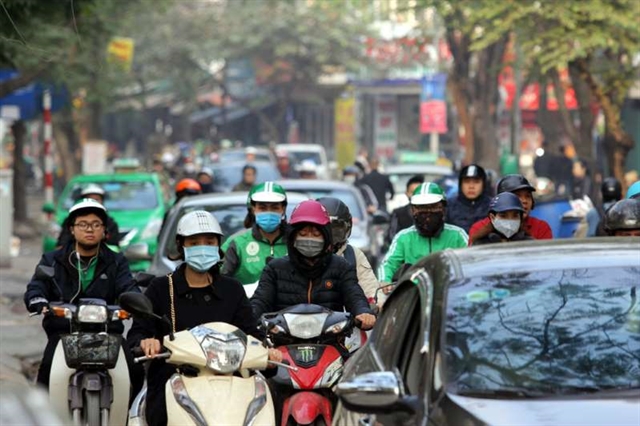 Society
Society


|
| Chùa Láng Street where three universities are located is one of the most severe black spots of congestion in Hà Nội. — Photo vtc.vn |
HÀ NỘI — Within one kilometre from Thăng Long Tobacco Factory to Co.op Mart on Hà Nội’s Nguyễn Trãi Street, seven universities are located.
With some 10,000 students at each school, despite being one of the city’s largest streets, it is still congested during peak hours every day.
The situation is the same around other university hubs in the city, from Xuân Thuỷ Street to Cầu Giấy Street with Việt Nam National University and Academy of Journalism and Communications; from Tây Sơn Street to Chùa Bộc Street with Thuỷ Lợi University, Trade Union University and Banking Academy; Giải Phóng Street with National Economics University, National University of Civil Engineering and Hà Nội University of Science and Technology; and Chùa Láng Street with Foreign Trade University, Diplomatic Academy and Việt Nam Youth Academy.
As the number of students from other provinces flocking into Hà Nội increases, the city’s traffic system faces a huge burden.
Captain Đinh Tiến Vũ from Hà Nội Traffic Police told Kinh tế & Đô Thị (Economic and Urban Affairs) newspaper that the sharp rise of vehicles and students was the main cause of congestion on the streets. The situation only improves during summer.
In 2007, a plan was approved to move university and college networks between 2006 and 2016 in which small-sized public universities (under 2ha) would move out to the suburbs to have bigger campuses of at least 10ha.
After Hà Nội’s administrative boundaries were expanded in 2009, there was another plan on developing university and college systems.
One of the plan’s goals is to “solve difficulties involving space and facilities of Hà Nội’s universities and colleges and their negative impacts on the city’s development”.
Therefore, it is set to reduce the density of students and schools in the inner city.
From 2010 to 2011, the Hà Nội Department of Planning and Architecture and Ministry of Construction composed plans to move and upgrade 23 higher education institutes.
Twelve schools planned to remove, including Hà Nội Law University, Foreign Trade University and Hà Nội Open University.
The schools were to be relocated in satellite areas of Gia Lâm (250ha), Sóc Sơn (600ha), Sơn Tây (300ha), Hoà Lạc (1,200ha) and Phú Xuyên (100ha), creating hubs of up to 4,500ha for each which can serve from 40,000 to 51,000 students.
The Hà Nội Capital construction master plan, approved in 2011, expects to restrain the number of university students in the metropolitan area at some 30,000.
However, after a decade, only the University of Public Health has moved out to Bắc Từ Liêm District.
Việt Nam National University, despite being granted a 1,000ha area in Hoà Lạc Hi-teck Park, has not followed the plan.
The university's vice rector Nguyễn Hoàng Hải could not confirm when the project would be completed due to difficulties in allocating investment.
For the past 15 years, the project has received less than 8 per cent of the initial estimated capital of VNĐ25.8 trillion (US$1.1 billion).
The situation is thought to be similar with the other institutions.
According to Đào Ngọc Nghiêm, deputy head of Hà Nội Association of Urban Planning and Development, universities have raised student enrollment despite not moving to outlying areas, increasing pressure on the city’s traffic infrastructure.
In addition, while Hà Nội is overloaded with universities and colleges, the Government has not created favourable conditions to develop higher education institutes in other nearby provinces.
To solve the problem, besides changes in policies, the expert highlighted the need for private sector participation in mobilising resources to build infrastructure and attract students. — VNS




